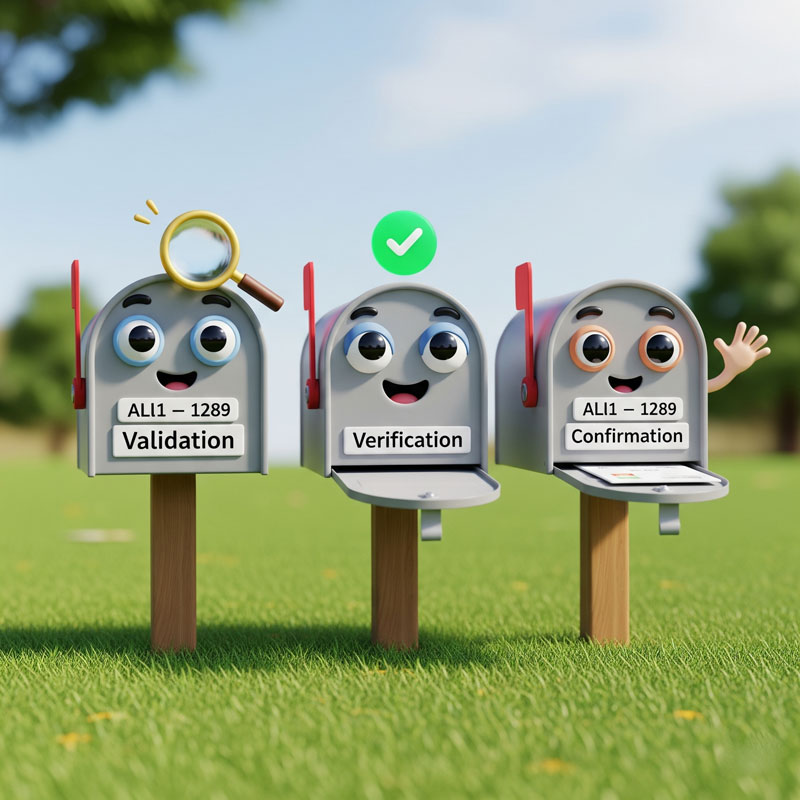Blog
Our Latest Insights
From warm-up tricks to deliverability hacks, our blog breaks down everything you need to know to land in the inbox and connect with your audience.
What Is Email Validation and Why Your Business Needs It

Imagine this: you’ve spent hours crafting the perfect email campaign. The subject line is catchy, the copy is compelling, and the call-to-action practically begs to be clicked. You hit “send,” sit back, and wait for the results—only to discover that a large chunk of your emails never even made it to their destinations. They bounced. Some addresses were fake, some had typos, and others were just abandoned mailboxes.
This is the painful reality for businesses that overlook email validation. It’s the invisible step that separates high-performing campaigns from wasted budgets. Let’s explore what email validation really means, how it works behind the scenes, and why your business simply can’t afford to skip it.

What Is Email Validation?
At its core, email validation is the process of checking whether an email address is correct, safe, and active. It ensures your list is free from junk data like typos, fakes, spam traps, or temporary addresses.
Validation typically includes:
-
Syntax check – making sure the email follows correct format rules (
This email address is being protected from spambots. You need JavaScript enabled to view it. passes, john@example fails). -
Domain check – confirming the domain exists and can accept mail.
-
Mailbox ping – a safe “handshake” with the server to see if the inbox is real.
-
Disposable email detection – spotting temporary accounts like 10MinuteMail.
-
Role-based email filtering – flagging addresses like support@ or admin@.
-
Spam trap avoidance – keeping you away from addresses designed to catch spammers.
Think of it as a background check for your email subscribers.

Email Validation vs. Verification vs. Confirmation
These three terms often get tossed around as if they mean the same thing, but they don’t.
Validation is about structure and possibility. It tells you whether an email could work.
Verification goes deeper and asks: does this inbox actually exist and accept mail right now?
Confirmation involves the human element: the user clicking a link in a “please confirm your email” message to prove they own the address.
Think of it like sending a letter. Validation makes sure you wrote the address correctly. Verification checks if there’s really a mailbox at that house. And confirmation is when the homeowner opens the door and waves hello. Together, the three steps create a reliable, safe list of contacts.

Why Email Validation Is a Business Essential
1. Protect Your Sender Reputation
Your sender reputation is like your email “credit score.” If it drops, inbox providers like Gmail or Outlook may block or filter your emails—even to good contacts. High bounce rates are the fastest way to damage it.
2. Save Money on Sending Costs
Most email service providers charge per contact or per send. Invalid addresses waste budget. By removing them, you send fewer emails but get better results.
3. Increase Engagement and ROI
When emails only go to real people, your open rates, click-throughs, and conversions rise. Higher engagement also boosts your inbox placement, creating a positive feedback loop.
4. Stop Fake Signups and Bots
Some users enter bogus addresses to grab freebies. Others are automated bots. Validation stops them from poisoning your database.
5. Simplify Compliance
Regulations like GDPR, CCPA, and CAN-SPAM require businesses to respect user data and consent. Validation helps demonstrate that your data is accurate and responsibly managed.
Real-World Scenarios
-
E-commerce Example: An online clothing brand collects thousands of signups during a holiday sale. Without validation, 15% of those addresses bounce. Their domain reputation suffers, and sales emails start landing in spam. With validation, only active, real addresses enter the system, keeping reputation strong and maximizing revenue.
-
SaaS Example: A startup offers free trials but notices lots of disposable emails like
This email address is being protected from spambots. You need JavaScript enabled to view it. . They validate at signup, blocking these throwaways. Their conversion-to-paid rate improves because every trial user is tied to a real inbox. -
B2B Example: A software company relies on webinars for lead generation. Many registrations come from role-based emails like
This email address is being protected from spambots. You need JavaScript enabled to view it. . They flag these addresses for manual review, ensuring real decision-makers get nurtured.

Real-Time Validation vs. Bulk Cleaning
There are two main ways businesses use validation. The first is real-time validation, which happens the moment someone enters their email on your site. If a visitor mistypes gmial.com instead of gmail.com, the system can prompt them to fix it before they hit submit. If they try using a disposable address, it can be blocked instantly. This keeps your list clean from the very beginning.
The second method is bulk cleaning, where you run your existing list through a validator. This is especially important if you’ve collected addresses over a long period of time. People abandon old inboxes, change jobs, or switch providers, and what was valid last year may not be valid today. Bulk cleaning allows you to sweep out the bad data before a big campaign, reducing your risk and improving performance.
Smart marketers use both. Real-time validation acts like a bouncer at the door, and bulk cleaning works like housekeeping to keep the whole place tidy.
-
Real-Time Validation
-
Happens instantly as a user types their email.
-
Corrects typos (“Did you mean @gmail.com?”).
-
Blocks fake or disposable addresses.
-
Best for signup forms, checkouts, and lead capture.
-
-
Bulk Cleaning
-
Scans existing lists (thousands or millions of contacts).
-
Categorizes addresses as valid, invalid, risky, or disposable.
-
Ideal before big campaigns, or quarterly database clean-ups.
-
Smart marketers use both: keep the front door clean and the back room tidy.

The Hidden Dangers of Disposable Emails
Temporary inboxes are the silent killer of list health. They:
-
Pass initial checks but vanish after 10 minutes.
-
Never engage, dragging down open rates.
-
Signal low-quality subscribers, hurting deliverability.
Blocking them saves you wasted effort and misleading metrics.
How Validation Works Behind the Scenes
If you’re curious about the mechanics, here’s a peek under the hood. Validation starts with regex rules—basically a set of patterns that check whether the email follows standard structure. Then it moves on to DNS lookups, which confirm the domain is set up to receive mail. Finally, there’s the SMTP handshake, a lightweight interaction with the mail server that determines whether the specific mailbox exists.
On top of this, most validation tools compare addresses against known lists of disposable domains, spam traps, and high-risk accounts. It’s a bit like airport security: you don’t just check if someone has a ticket, you also make sure their name isn’t on a watchlist.
Don’t Forget Authentication
Validation ensures the recipient is real, but you also need to prove that you are real. That’s where authentication protocols like SPF, DKIM, and DMARC come in. They act as digital signatures, letting inbox providers know your messages haven’t been forged or tampered with.
Think of it as showing ID at the door. Validation checks the guest list, but authentication proves you’re the rightful host. Together, they form a complete system of trust.
Bringing It All Together with Zharik
At Zharik, we know how frustrating it is to see your carefully designed campaigns fail because of something as small as a typo or a fake signup. That’s why we built our email verification tool to make validation easy and effective.
Whether you need real-time checks on your signup forms or bulk cleaning for a legacy list, Zharik has you covered. Our system detects disposables, filters out spam traps, and gives you clear, actionable results. You can integrate it into your workflows with minimal effort, and once it’s in place, you can finally stop worrying about bounces and start focusing on growth.
Frequently Asked Questions
What’s the difference between email validation and verification?
Validation checks structure and domain. Verification digs deeper, confirming that the mailbox exists and accepts messages.
How often should I validate my email list?
In real-time for new signups, and every 3–6 months for existing lists.
Can email validation improve deliverability?
Yes. By reducing bounces and protecting your sender reputation, validation increases your chances of landing in the inbox.
Is email validation GDPR compliant?
Yes, when handled correctly. Zharik’s tool is designed to meet GDPR and other data protection requirements.
Final Thought
Email validation might not be glamorous, but it’s the silent engine that powers successful campaigns. Without it, you’re building on quicksand—every bounce, every fake signup, every abandoned inbox chips away at your results. With it, you’re building on rock: solid, stable, and ready to grow.
The question isn’t whether your business can afford email validation. The real question is: can you afford to go without it?
We offer the best services for our customer


